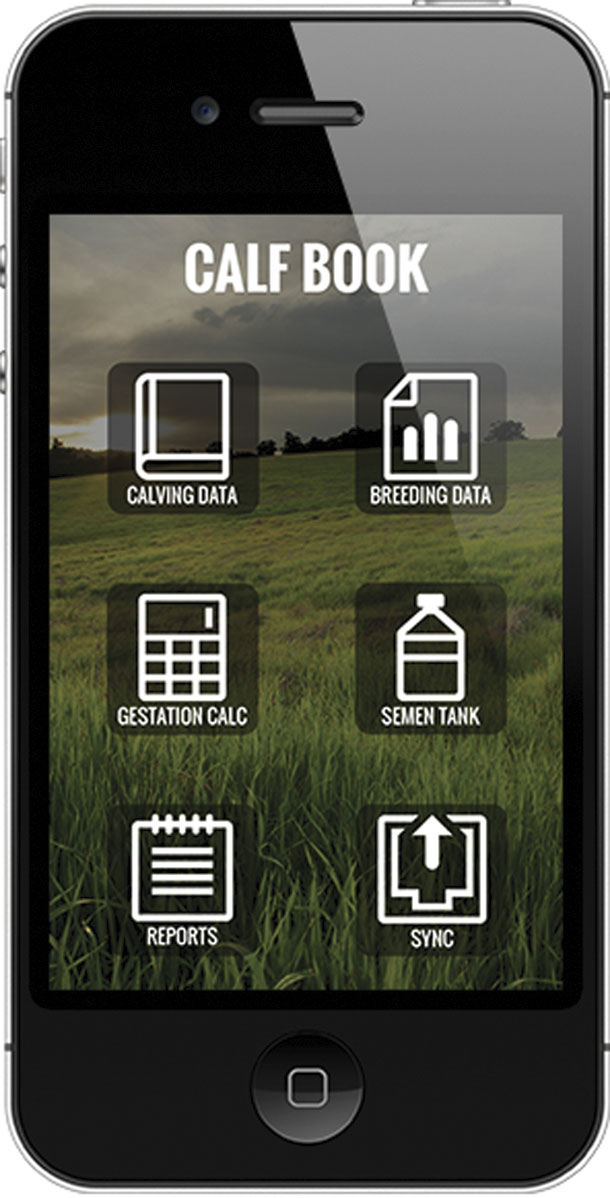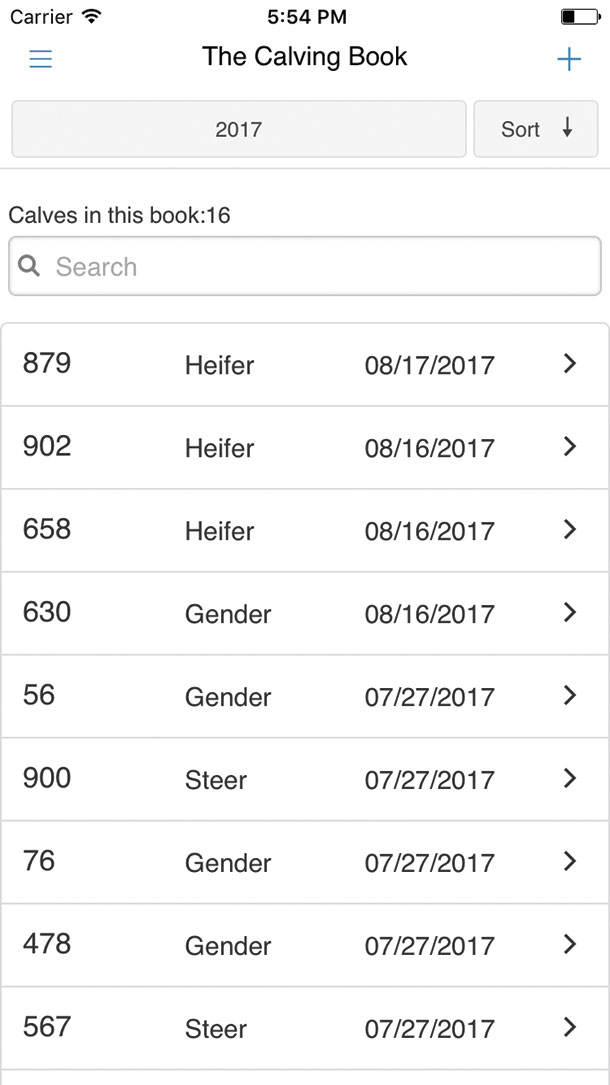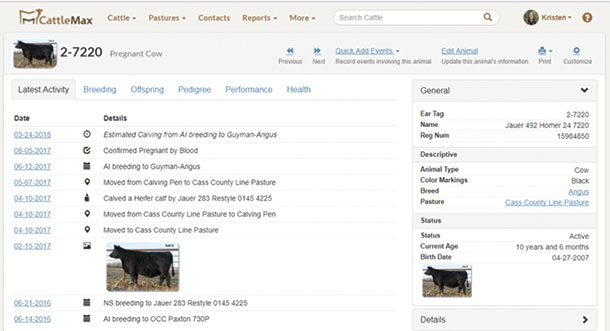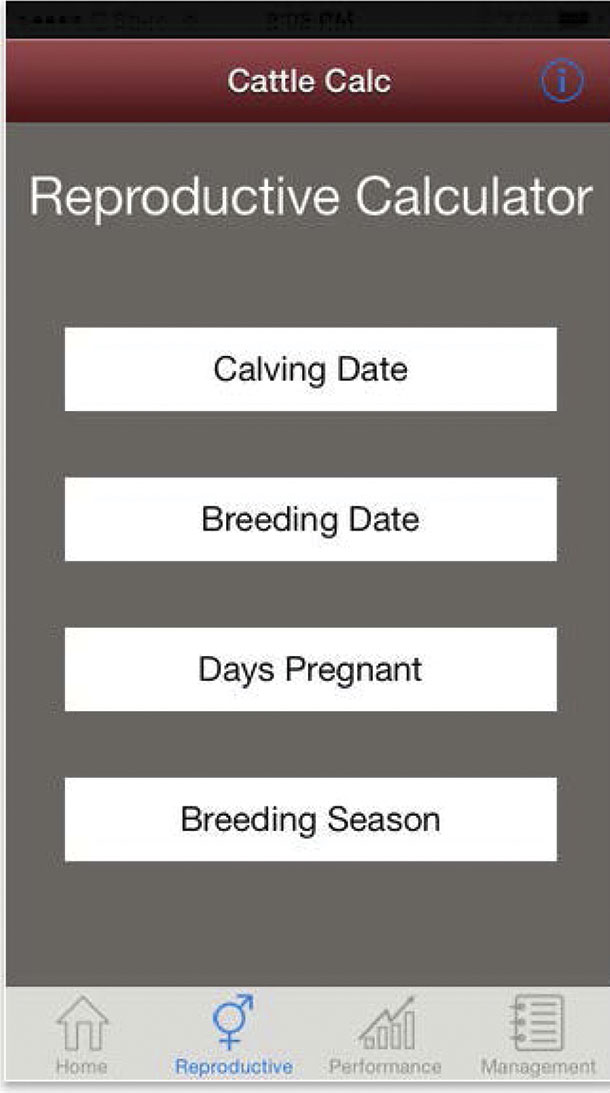Calf Book

Weyman Hunt, a registered Hereford producer from Georgia, needed something to track their calves. After trying it out at home, they put it on the market in 2015.
“The days of washing your calf book in your shirt pocket are done. That’s what I think a lot of people are afraid of: ‘What if I lose my phone?’ It’s all saved to the cloud. They can also get it on their website,” Hunt says.
When creating the app, Hunt wanted to make it so producers did not need to have cellular service to use it. Producers can input the data they want while out in the pasture or anywhere and then, once they get back to service, they can sync it so everyone is updated.
As producers put in the calf data, their data continues to build. Once the 2017 calving season is all done, producers can start a new sheet for 2018, but they still have the ability to look back at the 2017 calf crop. They can also add a calf from 2017 to the cow herd once it starts calving, but that calf’s information from calving is still in the calf list. All of her cow data continues in the cow list.
“Once you turn them into cows, they go into the cow list, and they can keep whatever records you need going forward. They still stay in the calf crop also, but you can pick and choose which ones go in the cow list. Then, when you sell them, you can deactivate them or whatever the case may be,” Hunt says.
Producers can also print reports like sale, breeding, weaning and yearling. They can sort by sire, sex, etc. Producers have been downloading the app all over the country and countries around the world.
Price: 21-day free trial, $5 annually for basic plan, $15 annually for plus plan, $25 annually for premier plan; all can have unlimited number of cattle
Works on: Apple and Android mobile devices, computer web browsers
Users: Unlimited people on the same account; everyone logs in with the same email and password
The Calving Book App

The Calving Book App launched in 2014 after Orient, South Dakota, rancher Ellen Schlecter’s family needed something to keep track of calves born on their ranch.
“We created the app because we had a need for it on our farm. We’ve got six guys who kind of just never knew where the calving book was. They left it in this pickup or that pickup or took it to the barn,” Schlecter says. “That was a big, big problem for us. This just seemed like the next logical step.”
She wanted to make the app as simple as possible since her father and uncles would be using it and knew how they operated.
“The app is super-easy to use. A lot of people, especially ranchers, producers could be intimidated to use an app to keep records just because it’s such a traditional industry, but when I designed it I knew who was going to have to use it because I work with my dad and my uncles. I knew how simple it had to be. It’s designed with ease of use in mind,” she says. “People should not be intimidated by it.”
The pro version of the app is for producers who want just a calving book and want to keep it simple. In the plus version of the app, they can input their calving records, breeding, weaning and preg-checking records.
Producers do not need to be connected to the internet to input their data. They can sync their data once they get back to service.
“They can enter their data offline and, depending on if it happens to load sometime while they do have a network connection, the phone will remember that, and then they can go back and look it up even when they don’t have a network connection,” she says.
The app has been downloaded by people all over the country and in more than 20 countries.
Price: 30-day free trial
Current price: $20 for the pro version, $25 for the plus version
Future: Changing over to a subscription service so tentative pro price will be $10, and plus will be $15 per year; all can have unlimited number of cattle
Works on: Apple and Android mobile devices, computer web browsers
Users: Unlimited people on the same account; everyone logs in with the same email and password
CattleMax
 CattleMax got its start in 1999 as a custom database for a commercial operation in the College Station, Texas, area. Today, the program is a complete production performance record-keeping software. Producers can keep calving records and health records and, on the registered version, they can also track pedigrees and EPDs.
CattleMax got its start in 1999 as a custom database for a commercial operation in the College Station, Texas, area. Today, the program is a complete production performance record-keeping software. Producers can keep calving records and health records and, on the registered version, they can also track pedigrees and EPDs.
CattleMax team member Kristen Evans says the program keeps up with electronic ID and RFID on all the versions they carry. They also have an iPhone and iPad app that works with EID tags.
In the registered versions, producers can add their breed association. When starting CattleMax, producers can request their whole-herd file from their association to import into CattleMax.
Once they input their herd information and then collect new data, they can send that information back to the association. Right now, they are working closely with the Angus, Hereford and Simmental associations.
“There’s a page that comes up, and you can basically send an electronic file to Angus and then, obviously, you would pay Angus for your registration setup, and then they’ll send the file back with all your registrations to import back into the program,” Evans says.
When inputting data, they need to have internet service. However, they can send a CSV file from Excel to themselves and put in the tags or weights and then import them back in once they get back to service.
If producers work calves in one day, they can update them as a group by selecting all of them to say all of those calves received a particular shot.
CattleMax comes with 35 standard reports. Evans says CattleMax is a tool producers can use to get more organized.
“Our philosophy at CattleMax is just becoming better organized, save time and improve the decision-making process. We’re very aware it takes a lot of effort to collect data, whether it’s a piece of paper or on a computer. That’s where CattleMax comes in. We try to make it as easy as possible for our users,” she says.
CattleMax offers free support and service. They also offer online classes about the program once or twice a month.
Price: 21-day free trial
Commercial: $9 per month for up to 100 animals; $14 per month for up to 500 animals; $24 per month for up to 1,000 animals; $44 per month for unlimited animals
Registered: $15 per month for up to 100 animals; $25 per month for up to 500 animals; $45 per month for up to 1,000 animals; $85 per month for unlimited animals
Works on: Apple and Android mobile devices, computer web browsers
Users: Unlimited people on the same account; each has their own login information
Mississippi State University Extension Service Cattle Calculator
 Mississippi State University Extension beef specialist Brandi Karisch and a team of beef professors and the university’s ag communication department developed the Cattle Calculator app in 2013.
Mississippi State University Extension beef specialist Brandi Karisch and a team of beef professors and the university’s ag communication department developed the Cattle Calculator app in 2013.
Karisch says they decided to develop the app because producers are carrying around a mini computer in their pockets with their cellphones.
“Our idea was to put some simple calculations in one place, which is the app that we came up with to have it all in one place and make it a little bit easier for them to work with,” she says.
While it does not keep track of calves born on the farm, producers can use it to calculate expected calving dates, breeding date and breeding season. For example, Karisch says if a producer wants a 45-day calving season and wants to turn the bull out on a certain day, the app will tell them when to turn those bulls out, what day to pull the bulls and what day the calving season is expected to begin and end.
The reproductive calculator also calculates days pregnant for those producers doing embryo transfer work. “I had a comment from someone whose business is doing embryo transfer work, and he says, ‘It would sure be handy if when we were out there preg checking those cows, we could have a days pregnant calculator so we know what days we put the embryos in and we know what day we’re preg checking to make it a little bit easier to try to figure out how long they should be,’” she says.
Besides the reproductive calculator, producers can use the MSUES Cattle Calculator to calculate adjusted weights and average daily gains. They can also determine medicine dosage.
“That’s one we think is super-important to make sure that producers are getting their dosages right,” Karisch says.
Producers can also calculate frame score and trailer stocking density. Producers put in the size of the trailer and the estimated weight of the animals to determine how many to load.
“How many calves can they realistically fit on that trailer? Usually, I jokingly tell producers the answer is not just one more,” Karisch says.
The app is designed to work on mobile devices such as phones and tablets – but not for computers.
The app has been downloaded all around the world and across the U.S. In the future, they want to convert their beef pocket guide into an app and develop a database app. The university’s wildlife team has developed other apps dealing with deer management.
“It’s been very well received. We promoted it a good bit early on, and then when we got the Android version as well,” she says.
Price: Free
Works on: Apple and Android mobile devices ![]()
PHOTO 1: “The days of washing your calf book in your shirt pocket are done. That’s what I think a lot of people are afraid of: ‘What if I lose my phone?’ It’s all saved to the cloud. They can also get it on their website.”
PHOTO 2: Calf Book
PHOTO 3: CattleMax
PHOTO 4: Cattle Calc. Courtesy images.
Wendy Sweeter is a freelance writer based in South Dakota. Email Wendy Sweeter.







